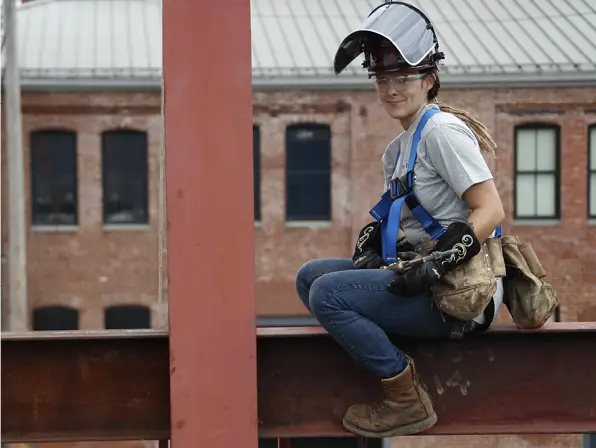We all know that every field job in the world has various risks involved and the only way to keep yourself safe and protected is by following the guidelines that are normally laid out when you sign up for the job.
Ironworkers have to adhere to such guidelines and more when they decide to take up this physically demanding job. It involves a lot of danger and more often than not there is a risk of getting severely hurt or injured while on the job.
Have you ever noticed an ironworker tuck their pants in their boots, and wondered why they do that? This is not because they want to be stylish, but they do this to stay safe while working. It is a way for them to avoid tripping by getting caught up in their own pants.

Ironworkers also wear boots without any heels and that have wedges so they are more comfortable and have better grip as such boots provide the best traction.
In this article, I have discussed more on the kind of gear ironworkers should wear when working and also the kind of dangers they face daily.
What dangers do ironworkers face at work?
As an ironworker, you have to work with metal which is a very tough material itself that comes with several risks. Apart from that, there are other dangers and risks that come with the job which are mentioned below.
1.) Risk of falling
First and foremost there is the risk of falling from higher surfaces because a lot of the job requires the worker to climb to higher levels from the ground.
If there is even a single misstep while working you can slip and fall, leading you to get severely injured or worse, die.
An ironworker’s job does not stop according to the weather, therefore, you need to be more careful when working in the rain or on ice.
2.) Risk of getting cuts
When you work with metal there is the risk of getting cuts by sharp edges or simply put sharp metal. Even the machines that you need to use for working with iron come with blades that can easily cut your hands and legs.
This can result in you having to get stitches and in some cases, the wound can get infected or permanently wrecked. Hence, you need to be on alert mode while dealing with such machinery and materials.
3.) Risk of getting burnt
A lot of welding is involved in this occupation, which can be quite dangerous for the worker. There are sparks flying all over the place when welding, which can land in your eyes, clothes, hands, etc.
You can get burnt if not in proper protective gear while working. Even the vapors and heat generated from welding may result in combustible things catching fire.
4.) Risk of muscle strain
When you have to work with different types of metal which can be heavy or light depending on the project at hand, you may have to move around with the materials. And there is a lot of bending, standing, walking, stretching, etc. involved in the job.
This can result in extreme strain on your muscles. Hence, an ironworker has to be more prepared for such unforeseen circumstances and be careful while lifting such heavy objects.
These are some of the most common risks and dangers that an ironworker faces on a daily basis at their workplace.
What kind of protective gear should an ironworker wear?
In order to protect yourself from the various hazards that come with as an ironworker, you need to strictly wear certain types of gear.
1.) Protective clothes: The kind of clothes you wear are one of the most important things because they can easily catch fire or get caught on something, resulting in you getting burnt or fall. Your pants and sleeves should not have any cuffs whatsoever. Hence, choose your clothing wisely.
2.) Protection for your ears: You need to make sure that your ears are protected from all kinds of sounds caused by hammering, reaming, and equipment. Therefore, you should wear adequate hearing protection that can prevent harm to your ears.
The protection you wear should be able to block out noise that goes above 85 decibels, but lets you hear your fellow co-workers, warnings, or alarms of any kind. Your hands should be clean prior to using hearing protection to avoid any sort of infection.
3.) Protection for your eyes: There are several types of work that an ironworker has to do on a daily basis. Such as, reaming, drilling, grinding, burning, welding, etc., hence, you must wear the appropriate eye protection gear.
By appropriate I mean it should be the right eye protection for the activity you are about to commence because each activity requires different eye protection. For activities like cutting and stud welding, you will need to wear Class 2C goggles to protect you from harmful radiation.
Similarly, for grinding and cutting you will have to wear a complete face shield that will minimize the dangers of particles and objects flying into your eyes.
While some job sites have made it mandatory to wear eye protection, there are some places that still haven’t, so you should make the decision of protecting yourself at all times.
4.) Protection for your skin: It is very easy to burn your skin as an ironworker because you have to work with hot metal, and the sometimes even under the hot sun. Working under the sun can burn your skin with ultraviolet radiation, and while welding you can be harmed by welding radiation.
Therefore, it is vital for you to wear clothes that are resistant to flames and also that can protect you against UV rays. The ideal clothing should consist of full-sleeved shirts, full length pants, and leather-faced gloves.
Other than the clothing you should also wear sunscreen with SPF 15 and higher. The gloves will protect your skin against hot steel and abrasions.
5.) Protection for your head: The risk of hurting your head is always a possibility when working as an ironworker. Hence, it is best to wear a hard hat that complies with the Construction Regulation, so you can protect your head against any kind of impact.
An ideal hard hat for ironworkers is a CSA Type 2 Class E or a similar a hat with a chinstrap. It is important to note that the right way to wear the hard hat is with its brim forward and not backwards unless specified by the particular manufacturer.
6.) Protection for your feet: The feet also need to be protected with the right kind of footwear which should be Grade 1 boots certified by CSA. For ironworkers, the ideal boots should have resistance against electric shocks, and should also be slip-resistant.
7.) Protection for your hands: Even your hands need to be protected against cuts and abrasions, which is why you need to wear the right gloves. You should choose your gloves according to the kind of work you have to do and the also keep in mind the temperatures or weather conditions.
If you follow and adhere to the above mentioned points, you will be reducing the risk of injuring yourself to a great extent.
Wrapping up
All jobs come with their set of pros and cons. Ironworkers are no different, except with more risks involved. The U.S. Department of Labour did a study various high risk jobs and concluded that ironworkers have the highest number of injuries among many other such jobs.
Apart from taking all the precautionary measures to protect oneself, it is also important to be well trained in this field and be prepared for any disasters.
It is no surprise that ironworkers have to climb large structures like bridges and buildings, adding to that they also have to be very nimble to be able to balance while climbing.
Always remember to wear the right gear and carry the right equipment which should include safety belts, nets, and arenas. As long as you are being responsible and looking out for your co-workers, you will be reducing the risks involved with this job to a great extent. So be safe out there!







